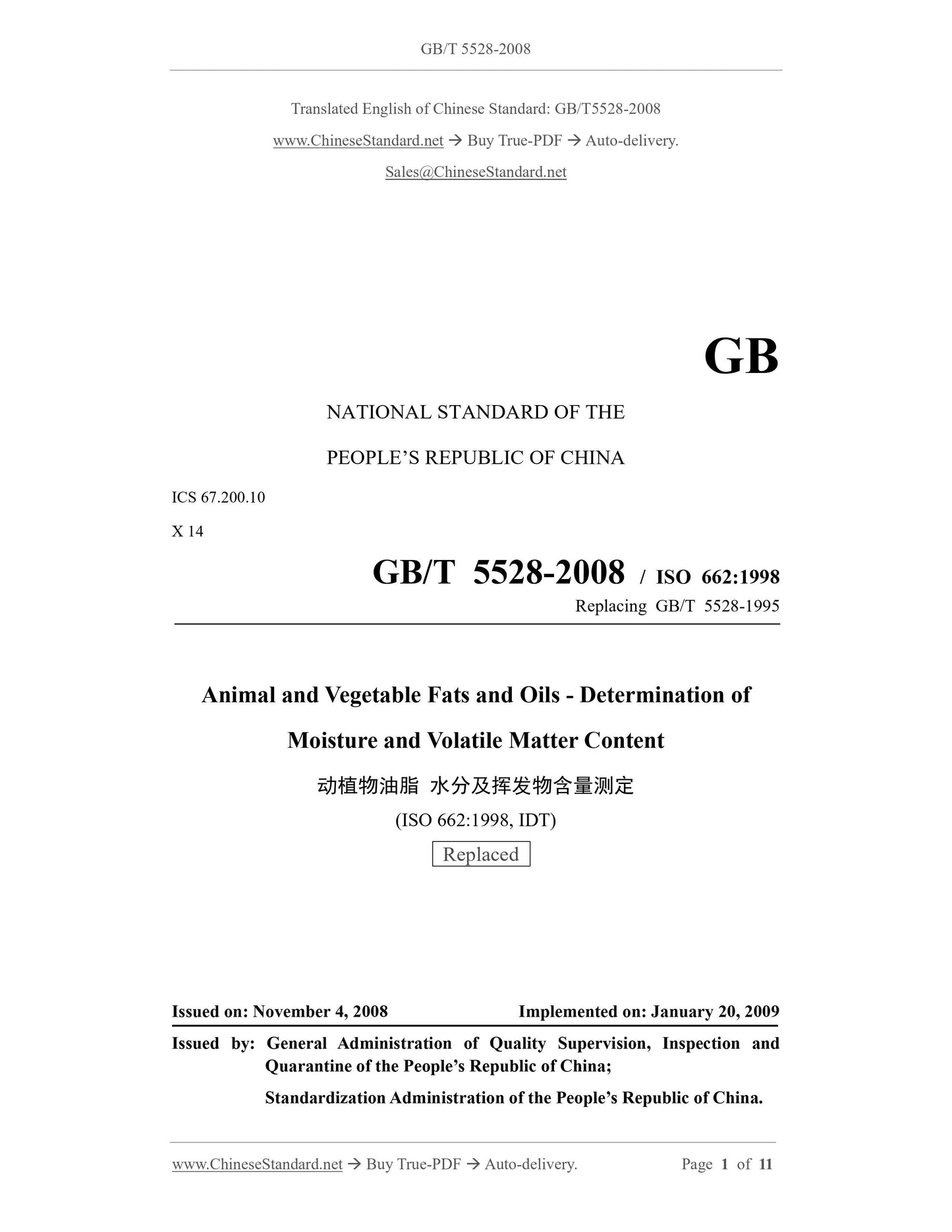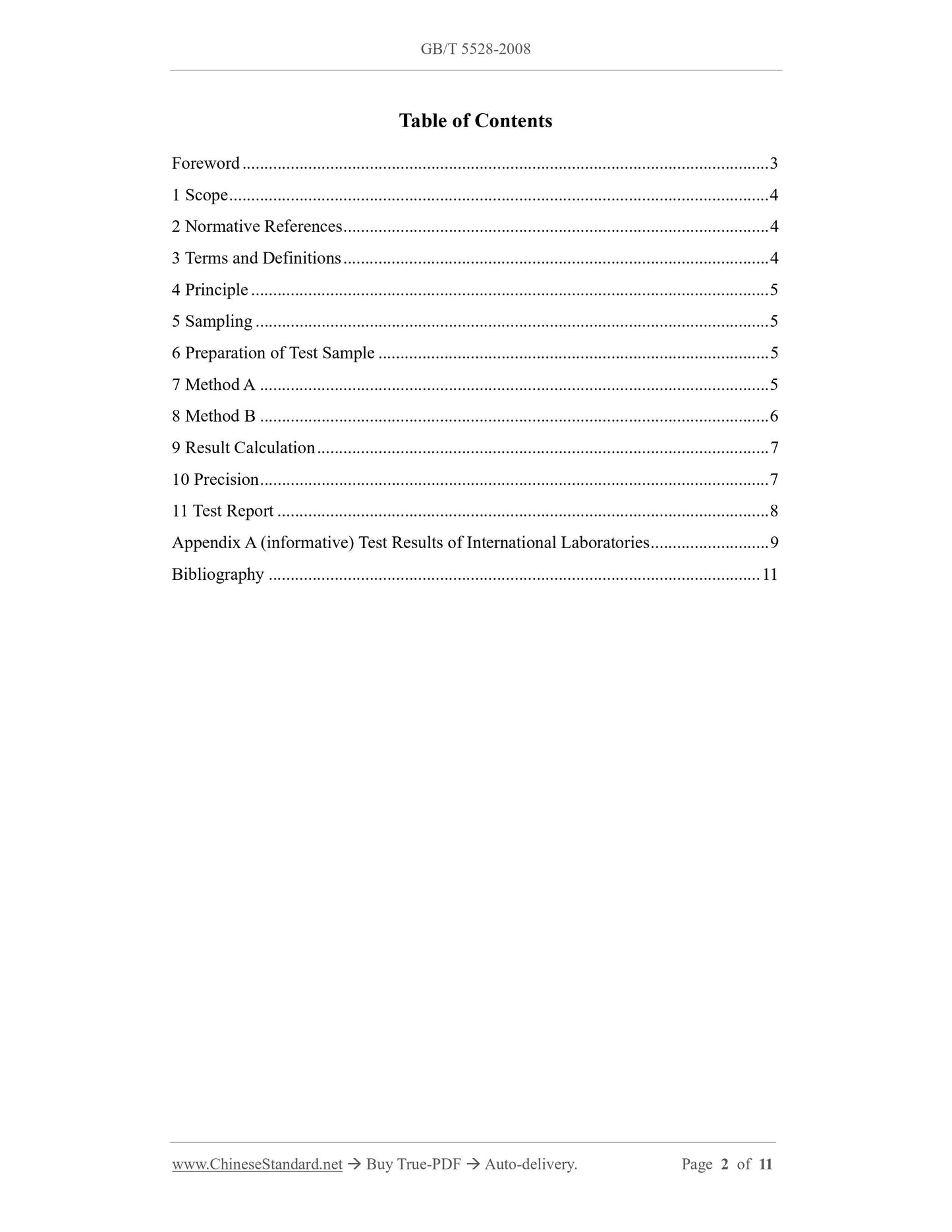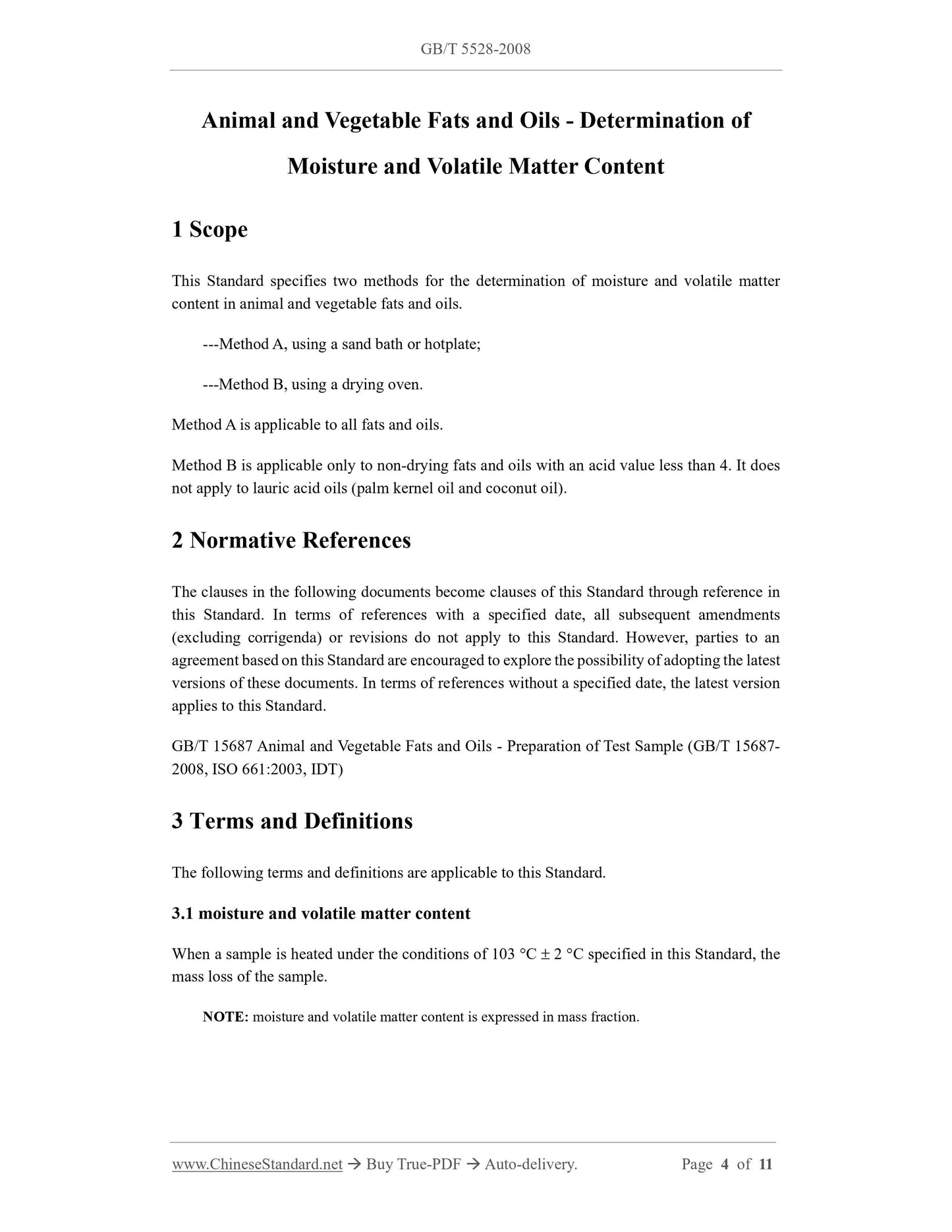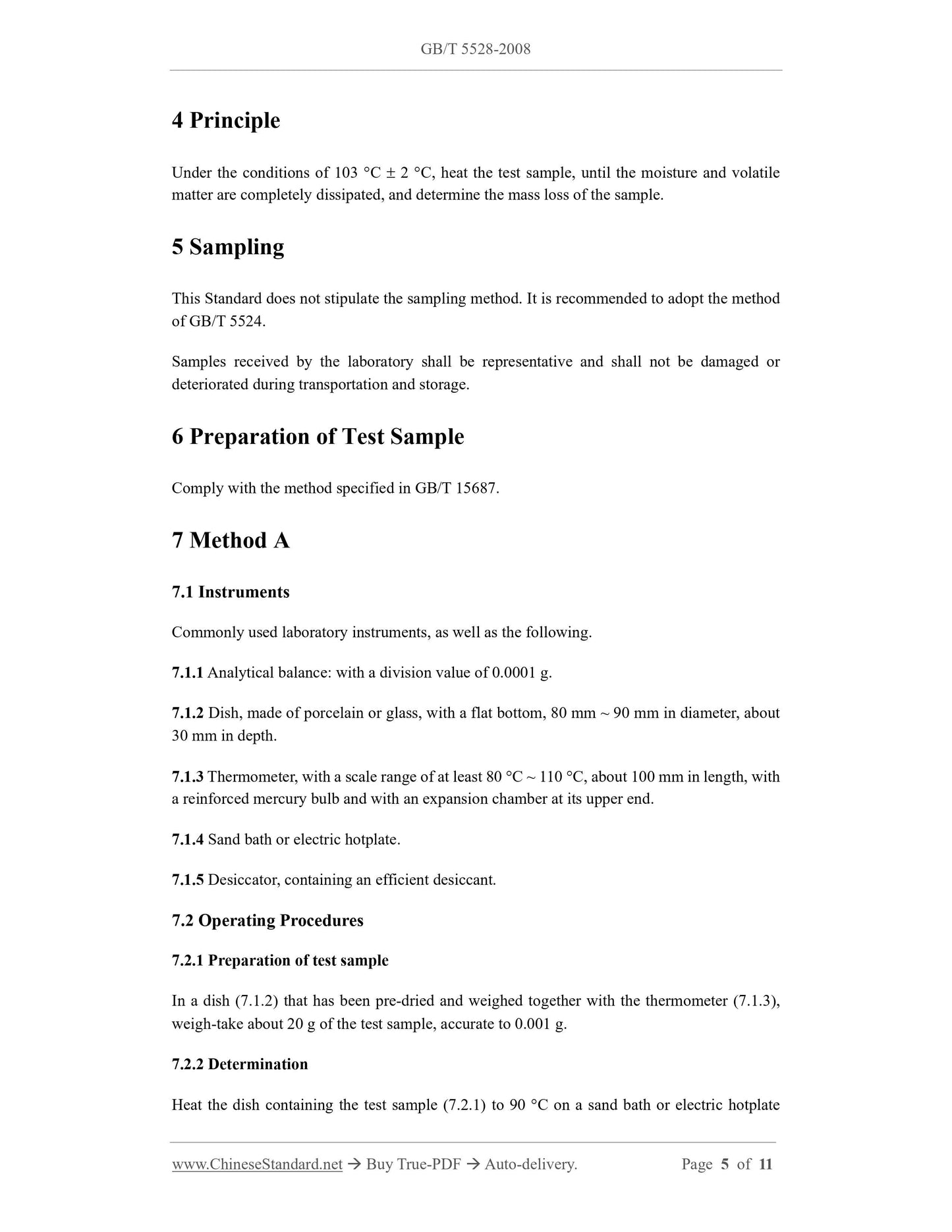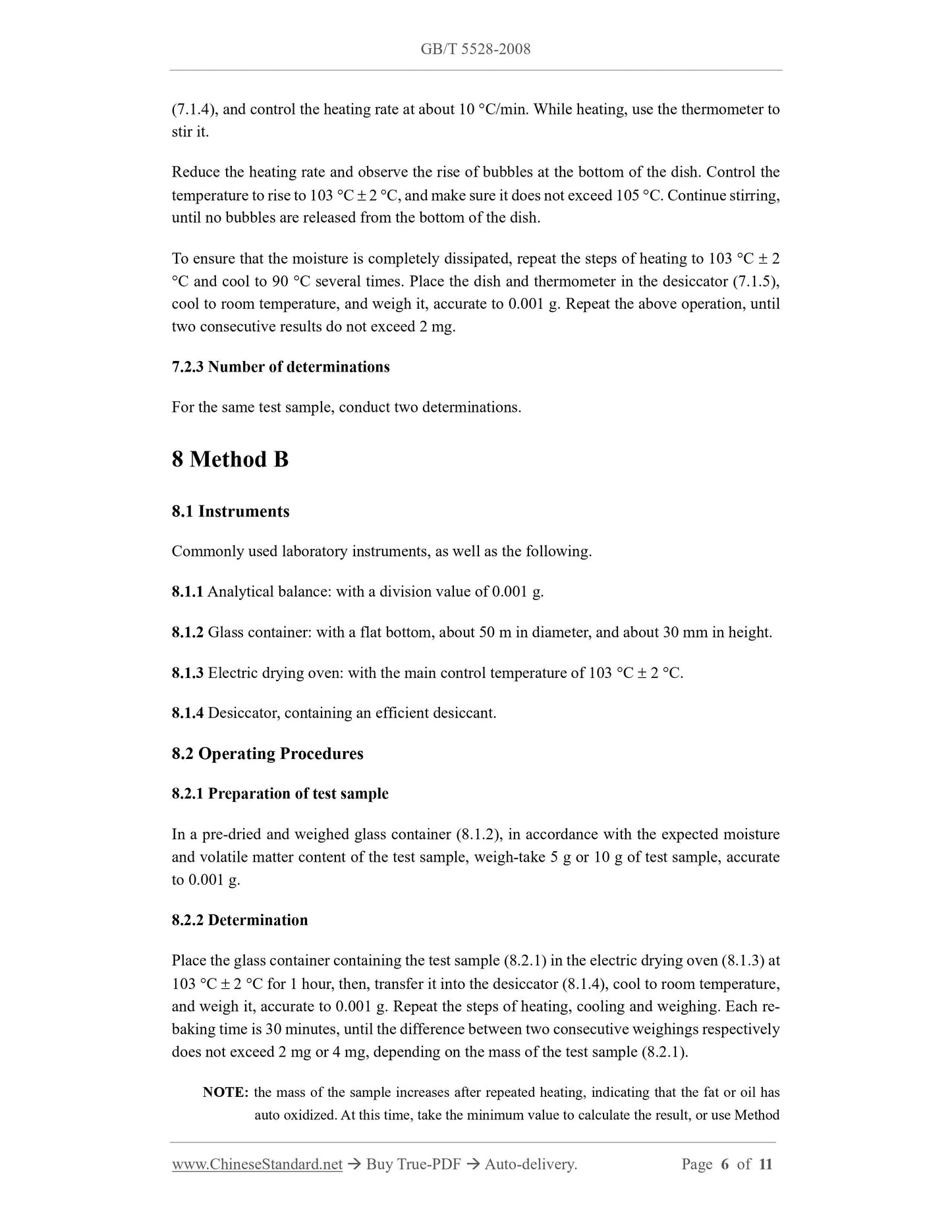1
/
of
5
PayPal, credit cards. Download editable-PDF and invoice in 1 second!
GB/T 5528-2008 English PDF (GBT5528-2008)
GB/T 5528-2008 English PDF (GBT5528-2008)
Regular price
$310.00 USD
Regular price
Sale price
$310.00 USD
Unit price
/
per
Shipping calculated at checkout.
Couldn't load pickup availability
Delivery: 3 seconds. Download true-PDF + Invoice.
Get QUOTATION in 1-minute: Click GB/T 5528-2008
Historical versions: GB/T 5528-2008
Preview True-PDF (Reload/Scroll if blank)
GB/T 5528-2008: Animal and vegetable fats and oils -- Determination of moisture and volatile matter content
GB/T 5528-2008
GB
NATIONAL STANDARD OF THE
PEOPLE’S REPUBLIC OF CHINA
ICS 67.200.10
X 14
GB/T 5528-2008 / ISO 662:1998
Replacing GB/T 5528-1995
Animal and Vegetable Fats and Oils - Determination of
Moisture and Volatile Matter Content
(ISO 662:1998, IDT)
Replaced
ISSUED ON: NOVEMBER 4, 2008
IMPLEMENTED ON: JANUARY 20, 2009
Issued by: General Administration of Quality Supervision, Inspection and
Quarantine of the People’s Republic of China;
Standardization Administration of the People’s Republic of China.
Table of Contents
Foreword ... 3
1 Scope ... 4
2 Normative References ... 4
3 Terms and Definitions ... 4
4 Principle ... 5
5 Sampling ... 5
6 Preparation of Test Sample ... 5
7 Method A ... 5
8 Method B ... 6
9 Result Calculation ... 7
10 Precision ... 7
11 Test Report ... 8
Appendix A (informative) Test Results of International Laboratories ... 9
Bibliography ... 11
Animal and Vegetable Fats and Oils - Determination of
Moisture and Volatile Matter Content
1 Scope
This Standard specifies two methods for the determination of moisture and volatile matter
content in animal and vegetable fats and oils.
---Method A, using a sand bath or hotplate;
---Method B, using a drying oven.
Method A is applicable to all fats and oils.
Method B is applicable only to non-drying fats and oils with an acid value less than 4. It does
not apply to lauric acid oils (palm kernel oil and coconut oil).
2 Normative References
The clauses in the following documents become clauses of this Standard through reference in
this Standard. In terms of references with a specified date, all subsequent amendments
(excluding corrigenda) or revisions do not apply to this Standard. However, parties to an
agreement based on this Standard are encouraged to explore the possibility of adopting the latest
versions of these documents. In terms of references without a specified date, the latest version
applies to this Standard.
GB/T 15687 Animal and Vegetable Fats and Oils - Preparation of Test Sample (GB/T 15687-
2008, ISO 661:2003, IDT)
3 Terms and Definitions
The following terms and definitions are applicable to this Standard.
3.1 moisture and volatile matter content
When a sample is heated under the conditions of 103 C 2 C specified in this Standard, the
mass loss of the sample.
NOTE: moisture and volatile matter content is expressed in mass fraction.
4 Principle
Under the conditions of 103 C 2 C, heat the test sample, until the moisture and volatile
matter are completely dissipated, and determine the mass loss of the sample.
5 Sampling
This Standard does not stipulate the sampling method. It is recommended to adopt the method
of GB/T 5524.
Samples received by the laboratory shall be representative and shall not be damaged or
deteriorated during transportation and storage.
6 Preparation of Test Sample
Comply with the method specified in GB/T 15687.
7 Method A
7.1 Instruments
Commonly used laboratory instruments, as well as the following.
7.1.1 Analytical balance: with a division value of 0.0001 g.
7.1.2 Dish, made of porcelain or glass, with a flat bottom, 80 mm ~ 90 mm in diameter, about
30 mm in depth.
7.1.3 Thermometer, with a scale range of at least 80 C ~ 110 C, about 100 mm in length, with
a reinforced mercury bulb and with an expansion chamber at its upper end.
7.1.4 Sand bath or electric hotplate.
7.1.5 Desiccator, containing an efficient desiccant.
7.2 Operating Procedures
7.2.1 Preparation of test sample
In a dish (7.1.2) that has been pre-dried and weighed together with the thermometer (7.1.3),
weigh-take about 20 g of the test sample, accurate to 0.001 g.
7.2.2 Determination
Heat the dish containing the test sample (7.2.1) to 90 C on a sand bath or electric hotplate
(7.1.4), and control the heating rate at about 10 C/min. While heating, use the thermometer to
stir it.
Reduce the heating rate and observe the rise of bubbles at the bottom of the dish. Control the
temperature to rise to 103 C 2 C, and make sure it does not exceed 105 C. Continue stirring,
until no bubbles are released from the bottom of the dish.
To ensure that the moisture is completely dissipated, repeat the steps of heating to 103 C 2
C and cool to 90 C several times. Place the dish and thermometer in the desiccator (7.1.5),
cool to room temperature, and weigh it, accurate to 0.001 g. Repeat the above operation, until
two consecutive results do not exceed 2 mg.
7.2.3 Number of determinations
For the same test sample, conduct two determinations.
8 Method B
8.1 Instruments
Commonly used laboratory instruments, as well as the following.
8.1.1 Analytical balance: with a division value of 0.001 g.
8.1.2 Glass container: with a flat bottom, about 50 m in diameter, and about 30 mm in height.
8.1.3 Electric drying oven: with the main control temperature of 103 C 2 C.
8.1.4 Desiccator, containing an efficient desiccant.
8.2 Operating Procedures
8.2.1 Preparation of test sample
In a pre-dried and weighed glass container (8.1.2), in accordance with the expected moisture
and volatile matter content of the test sample, weigh-take 5 g or 10 g of test sample, accurate
to 0.001 g.
8.2.2 Determination
Place the glass container containing the test sample (8.2.1) in the electric drying oven (8.1.3) at
103 C 2 C for 1 hour, then, transfer it into the desiccator (8.1.4), cool to room temperature,
and weigh it, accurate to 0.001 g. Repeat the steps of heating, cooling and weighing. Each re-
baking time is 30 minutes, until the difference between two consecutive weighings respectively
does not exceed 2 mg or 4 mg, depending on the mass of the test sample (8.2.1).
NOTE: the mass of the sample increases after repeated heating, indicating that the fat or oil has
auto oxidized. At this time, take the minimum value to calculate the result, or use Method
Get QUOTATION in 1-minute: Click GB/T 5528-2008
Historical versions: GB/T 5528-2008
Preview True-PDF (Reload/Scroll if blank)
GB/T 5528-2008: Animal and vegetable fats and oils -- Determination of moisture and volatile matter content
GB/T 5528-2008
GB
NATIONAL STANDARD OF THE
PEOPLE’S REPUBLIC OF CHINA
ICS 67.200.10
X 14
GB/T 5528-2008 / ISO 662:1998
Replacing GB/T 5528-1995
Animal and Vegetable Fats and Oils - Determination of
Moisture and Volatile Matter Content
(ISO 662:1998, IDT)
Replaced
ISSUED ON: NOVEMBER 4, 2008
IMPLEMENTED ON: JANUARY 20, 2009
Issued by: General Administration of Quality Supervision, Inspection and
Quarantine of the People’s Republic of China;
Standardization Administration of the People’s Republic of China.
Table of Contents
Foreword ... 3
1 Scope ... 4
2 Normative References ... 4
3 Terms and Definitions ... 4
4 Principle ... 5
5 Sampling ... 5
6 Preparation of Test Sample ... 5
7 Method A ... 5
8 Method B ... 6
9 Result Calculation ... 7
10 Precision ... 7
11 Test Report ... 8
Appendix A (informative) Test Results of International Laboratories ... 9
Bibliography ... 11
Animal and Vegetable Fats and Oils - Determination of
Moisture and Volatile Matter Content
1 Scope
This Standard specifies two methods for the determination of moisture and volatile matter
content in animal and vegetable fats and oils.
---Method A, using a sand bath or hotplate;
---Method B, using a drying oven.
Method A is applicable to all fats and oils.
Method B is applicable only to non-drying fats and oils with an acid value less than 4. It does
not apply to lauric acid oils (palm kernel oil and coconut oil).
2 Normative References
The clauses in the following documents become clauses of this Standard through reference in
this Standard. In terms of references with a specified date, all subsequent amendments
(excluding corrigenda) or revisions do not apply to this Standard. However, parties to an
agreement based on this Standard are encouraged to explore the possibility of adopting the latest
versions of these documents. In terms of references without a specified date, the latest version
applies to this Standard.
GB/T 15687 Animal and Vegetable Fats and Oils - Preparation of Test Sample (GB/T 15687-
2008, ISO 661:2003, IDT)
3 Terms and Definitions
The following terms and definitions are applicable to this Standard.
3.1 moisture and volatile matter content
When a sample is heated under the conditions of 103 C 2 C specified in this Standard, the
mass loss of the sample.
NOTE: moisture and volatile matter content is expressed in mass fraction.
4 Principle
Under the conditions of 103 C 2 C, heat the test sample, until the moisture and volatile
matter are completely dissipated, and determine the mass loss of the sample.
5 Sampling
This Standard does not stipulate the sampling method. It is recommended to adopt the method
of GB/T 5524.
Samples received by the laboratory shall be representative and shall not be damaged or
deteriorated during transportation and storage.
6 Preparation of Test Sample
Comply with the method specified in GB/T 15687.
7 Method A
7.1 Instruments
Commonly used laboratory instruments, as well as the following.
7.1.1 Analytical balance: with a division value of 0.0001 g.
7.1.2 Dish, made of porcelain or glass, with a flat bottom, 80 mm ~ 90 mm in diameter, about
30 mm in depth.
7.1.3 Thermometer, with a scale range of at least 80 C ~ 110 C, about 100 mm in length, with
a reinforced mercury bulb and with an expansion chamber at its upper end.
7.1.4 Sand bath or electric hotplate.
7.1.5 Desiccator, containing an efficient desiccant.
7.2 Operating Procedures
7.2.1 Preparation of test sample
In a dish (7.1.2) that has been pre-dried and weighed together with the thermometer (7.1.3),
weigh-take about 20 g of the test sample, accurate to 0.001 g.
7.2.2 Determination
Heat the dish containing the test sample (7.2.1) to 90 C on a sand bath or electric hotplate
(7.1.4), and control the heating rate at about 10 C/min. While heating, use the thermometer to
stir it.
Reduce the heating rate and observe the rise of bubbles at the bottom of the dish. Control the
temperature to rise to 103 C 2 C, and make sure it does not exceed 105 C. Continue stirring,
until no bubbles are released from the bottom of the dish.
To ensure that the moisture is completely dissipated, repeat the steps of heating to 103 C 2
C and cool to 90 C several times. Place the dish and thermometer in the desiccator (7.1.5),
cool to room temperature, and weigh it, accurate to 0.001 g. Repeat the above operation, until
two consecutive results do not exceed 2 mg.
7.2.3 Number of determinations
For the same test sample, conduct two determinations.
8 Method B
8.1 Instruments
Commonly used laboratory instruments, as well as the following.
8.1.1 Analytical balance: with a division value of 0.001 g.
8.1.2 Glass container: with a flat bottom, about 50 m in diameter, and about 30 mm in height.
8.1.3 Electric drying oven: with the main control temperature of 103 C 2 C.
8.1.4 Desiccator, containing an efficient desiccant.
8.2 Operating Procedures
8.2.1 Preparation of test sample
In a pre-dried and weighed glass container (8.1.2), in accordance with the expected moisture
and volatile matter content of the test sample, weigh-take 5 g or 10 g of test sample, accurate
to 0.001 g.
8.2.2 Determination
Place the glass container containing the test sample (8.2.1) in the electric drying oven (8.1.3) at
103 C 2 C for 1 hour, then, transfer it into the desiccator (8.1.4), cool to room temperature,
and weigh it, accurate to 0.001 g. Repeat the steps of heating, cooling and weighing. Each re-
baking time is 30 minutes, until the difference between two consecutive weighings respectively
does not exceed 2 mg or 4 mg, depending on the mass of the test sample (8.2.1).
NOTE: the mass of the sample increases after repeated heating, indicating that the fat or oil has
auto oxidized. At this time, take the minimum value to calculate the result, or use Method
Share
